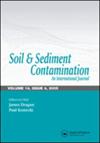Nitrification and utilization of ammonium and nitrate during oil bioremediation at different soil water potentials
IF 1.5
4区 环境科学与生态学
Q4 ENVIRONMENTAL SCIENCES
引用次数: 11
Abstract
Bioremediation of petroleum spills requires aerobic soil conditions and readily available N, which may be susceptible to leaching. Our objectives were to determine the influence of soil water potential on nitrification in the presence of crude oil, the toxicity of oil to NHj‐oxidizing bacteria, and the preferences of microorganisms for NH+ 4 or NO− 3. A Weswood clay loam was amended with crude oil to contain 0, 5, and 10% by soil dry weight, and N was added to achieve C:N ratios of 90:1 and 120:1. Soil water potentials were maintained at ‐0.02, ‐0.1, and ‐1.0 kJ/kg or allowed to fluctuate between ‐0.02 and ‐3 kJ/kg. Concentrations of NH+ 4 and NO3 −were measured during an incubation period of 40 d. Nitrification in soil not amended with oil was rapid at water potentials of ‐0.02 and ‐0.1 kJ/kg but inactive at a water potential of ‐1.0 kJ/kg. Oil reduced nitrification rates and populations of NH+ 4‐oxidizing bacteria. Little NO− 3 accumulated when the C:N ratio was 120:1, but when the C:N ratio was 90:1, u...不同土壤水势下石油生物修复过程中铵态氮的硝化作用及利用
石油泄漏的生物修复需要好氧土壤条件和容易获得的N,这可能容易淋出。我们的目的是确定原油存在时土壤水势对硝化的影响,油对NHj氧化细菌的毒性,以及微生物对nh4或NO−3的偏好。以土壤干重为0、5%和10%的原油对Weswood粘壤土进行改性,并添加N,使C:N比分别为90:1和120:1。土壤水势保持在‐0.02、‐0.1和‐1.0 kJ/kg,或允许在‐0.02和‐3 kJ/kg之间波动。在40 d的培养期间,测量了NH+ 4和NO3 -的浓度。在未加油的土壤中,硝化作用在- 0.02和- 0.1 kJ/kg的水势下迅速进行,但在- 1.0 kJ/kg的水势下不活跃。油降低了硝化速率和NH+ 4氧化细菌的数量。当C:N比为120:1时,NO−3积累较少,而当C:N比为90:1时,NO−3积累较少。
本文章由计算机程序翻译,如有差异,请以英文原文为准。
求助全文
约1分钟内获得全文
求助全文
来源期刊

Soil & Sediment Contamination
环境科学-环境科学
CiteScore
4.20
自引率
10.00%
发文量
53
审稿时长
2.2 months
期刊介绍:
When it comes to assessing and mitigating contaminated soils and sediments, there is no substitute for having the very latest tools, techniques and methodologies at your fingertips to help you deal with these issues efficiently and cost-effectively.
This is just the kind of essential expertise you’ll only find in Soil and Sediment Contamination . This internationally, peer-reviewed publication focuses on soil and sediment contamination from:
-Sludges-
Petroleum-
Petrochemicals-
Chlorinated hydrocarbons-
Pesticides-
Lead and other heavy metals.
Get detailed descriptions of all the latest and most efficient offsite and in situ remediation techniques, strategies for assessing health effects and hazards, and tips for dealing with everyday regulatory and legal issues. With the state-of-the-art tools that Soil and Sediment Contamination provides, you can successfully assess, mitigate, and solve both rural and urban soil contamination problems as efficiently and economically as possible.
 求助内容:
求助内容: 应助结果提醒方式:
应助结果提醒方式:


